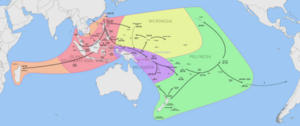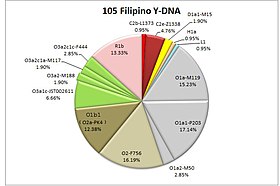필리핀인에 대한 유전자 연구
Genetic studies on Filipinos필리핀의 다양한 인종 집단의 인구 유전학을 분석하기 위해 필리핀 사람들에 대한 다양한 유전학 연구가 수행되었다.
The results of a massive DNA study conducted by the National Geographic's, "The Genographic Project", based on genetic testings of 80,000 Filipino people by the National Geographic in 2008–2009, found that the average Filipino's genes are around 53% Southeast Asia and Oceania, 36% East Asian, 5% Southern European, 3% South Asian and 2% Native Ameri통조림을 [1]하다
오리진스
최초의 오스트로네시아인들은 기원전 2200년경에 바타네스 제도와 북부 루손에 정착하면서 필리핀에 도착했다.그곳에서 그들은 필리핀과 동남아시아의 나머지 섬까지 빠르게 아래로 퍼져 나갔으며, 기원전 1500년 경까지 북마리아나 제도에 도달하기 위해 동쪽으로 더 멀리 항해했다.[2][3][4]그들은 구석기 시대에 도착한 나이든 네그리토 집단을 동화시켰고, 현대 필리핀 민족 집단은 모두 오스트로네시아와 네그리토 집단의 다양한 유전 혼화 비율을 보여준다.[5]
리즈 대학의 2008년 유전자 연구와 분자생물학 및 진화에서 발표된 연구는 미토콘드리아 DNA 선형이 약 5만년 전 현대인류가 도착한 이후 해양 동남아시아 내에서 진화하고 있다는 것을 보여주었다.저자들은 오스트로네시아인들이 동남아시아 섬 내에서 진화했고 대만에서 오지 않았다는 증거('선달랜드 밖' 가설)라고 결론지었다.해수면 상승과 동시에 인구분산이 발생했고, 이로 인해 필리핀 군도에서 지난 1만년 이내에 대만으로 이주가 이루어졌다.[6]
하지만, 이러한 것들은 네이처가 2014년에 발표한 연구 결과에 의해 (mtDNA 대신) 전체 게놈 염기서열 분석법을 통해 부인되어 왔는데, 이 연구는 모든 ISEA 개체들이 원주민 대만에서 유래한 유전자를 가지고 있다는 것을 밝혀냈다.'순달랜드 외' 가설에서 남북이민에 대한 주장과 달리, 새로운 전체 게놈 분석은 지배적인 '대만 외' 가설에서 오스트리아인들의 남북 분산을 강력하게 확인시켜 준다.연구진은 또 인간이 적어도 4만년 동안 선달랜드에 살고 있는 동안 오스트로네시아인들이 최근 입국했다는 점을 지적했다.2008년 연구 결과는 더 오래되었지만 관련이 없는 네그리토와 파푸아 인구를 혼용하는 것을 고려하지 못했다.[7][5]
2021년부터 필리핀의 현대 인종 집단의 조상 구성에 관한 또 다른 연구 결과에서도 뚜렷이 구별되는 바살-동아시아(동-유라시아) 조상은 동남 아시아 본토에서 기원한 것이 약 5만BC이며, 각각 남쪽과 북쪽의 여러 이주 파동을 통해 확장되었다고 한다.바살-동아시아 조상은 물론, 이후 동남아시아 본토에서 온 오스트리아-동아시아 조상은 오스트로네시아의 팽창에 앞서 필리핀에 도착했다.오스트로네시아어 사용자들은 1만 명 사이에 대만과 필리핀 북부에 도착했다고 한다.BC~7,000BC는 중국 남부 해안에서 왔다.저자들은 오스트로네시아의 인슐라 동남아와 폴리네시아로의 확장은 대만보다는 필리핀에서 외향적인 것으로, 현대의 오스트로네시아어를 구사하는 사람들은 초기 바살동아시아인, 동남아시아에서 온 오스트리아인 이주자들, 그리고 오스트로네시아어를 구사하는 뱃사람들로부터 주로 조상이 있다고 결론지었다.그는 필리핀이다.[8]
Y-DNA 하플로그룹
The most frequently occurring Y-DNA haplogroups among modern Filipinos are haplogroup O1a-M119, which has been found with maximal frequency among the indigenous peoples of Nias, the Mentawai Islands, northern Luzon, the Batanes, and Taiwan, and Haplogroup O2-M122, which is found with high frequency in many populations of East Asia, Southeast Asia,폴리네시아도 있고특히 O-P164(xM134)라는 필리핀 일반인들 사이에서 자주 발견되는 O2-M122의 종류는 폴리네시아인을 포함한 다른 오스트리아인 인구에서도 자주 발견된다.[9][10]Trejaut et al. 2014 found O2a2b-P164(xO2a2b1-M134) in 26/146 = 17.8% of a pool of samples of Filipinos (4/8 = 50% Mindanao, 7/31 = 22.6% Visayas, 10/55 = 18.2% South Luzon, 1/6 = 17% North Luzon, 2/22 = 9.1% unknown Philippines, 2/24 = 8.3% Ivatan).The distributions of other subclades of O2-M122 in the Philippines were sporadic, but it may be noted that O2a1b-JST002611 was observed in 6/24 = 25% of a sample of Ivatan and 1/31 = 3.2% of a sample from the Visayas, O2a2a1a2-M7 was observed in 1/6 = 17% of a sample from North Luzon, 1/55 = 1.8% of a sample from South Luzon, and 1/31 = 3.2% of a비사야에서 추출한 샘플과 O2a2b1a1a-M133은 비사야에서 추출한 샘플의 2/31 = 6.5%에서 관찰되었다.[9]표본 필리핀인의 총 45/146 = 30.8%가 하플로그룹 O2-M122에 속하는 것으로 나타났다.[9]In a study by Delfin et al. (2011), 21.1% (8/38) of a sample of highlanders of northern Luzon (17 Bugkalot, 12 Kalangoya, 6 Kankanaey, 2 Ibaloi, and 1 Ifugao) were found to belong to haplogroup O2a2a1a2-M7, which is outside of the O2a2b-P164 clade and is uncommon among Austronesian-speaking populations, being rather frequently observed among speak중국 남서부 및 동부 본토 동남아의 흐몽미엔어, 카투어어어, 바나리어의 어스.[11] (델핀 외 연구진도 5/39년 O-M7을 관측했는데, 루손 남동부의 이리가에서 아그타 표본의 12.8%, 파나이에서 아티 표본의 5/36 = 13.9%)[11]Haplogroup O1a-M119 is also commonly found among Filipinos (25/146 = 17.1% O1a-M119(xO1a1a-P203, O1a2-M50), 20/146 = 13.7% O1a1a-P203, 17/146 = 11.6% O1a2-M50, 62/146 = 42.5% O1a-M119 total according to Trejaut et al. 2014) and is shared with other Austronesian-speaking populations, especially those in Taiwan, western Indonesia, and Madagascar.[12]
라틴 아메리카/멕시코 및 페루 출신
스테파니 J. Mawson이 저서 "Convicts or Copistadores? (멕시코와 페루)에서 설명한 다양한 인종(아메린디안, 메스티조, 카스티조)으로 구성된, 라틴 아메리카(멕시코와 페루)에서 필리핀으로의 군사적 본질이 이주가 있었다.17세기 태평양의 스페인 군인"[13]또한 그녀의 논문에서 '충성과 불복종 사이:'17세기 태평양에서의 스페인 지배의 한계'는 1600년대 중남미에서 필리핀으로 파견된 누적 군인 1만5600명을 기록했다.[14]필리핀에 파견된 1만5600명의 라틴계 인구는 66만7612명에 불과했다.[15]
유럽 / 스페인 출신
16세기 이후 식민지 시대는 다른 인구로부터 유전적 영향의 유입을 보았다.이는 필리핀 인구 중 Y-DNA Happlogroup R1b가 차지하는 비중이 작다는 점에서 증명된다.DNA 연구는 이러한 선들이 얼마나 작은가에 따라 다양하다.스탠포드 대학 아시아 태평양 연구 센터가 실시한 2001년 연구에 따르면, 필리핀 인구의 3.6%만이 유럽 Y-DNA를 가지고 있다고 한다.샌프란시스코 캘리포니아 대학의 또 다른 유전자 연구에 따르면, 그들은 필리핀인으로 자칭한 일부 응답자들 사이에서 더 많은 양의 유럽 유전자가 발견되었다고 한다.[16]Kaiser Permanente (KP) 유전자, 환경, 건강 (RPGEH)에 관한 연구 프로그램의 연구 결과는 샘플링된 대부분의 필리핀 사람들이 오래된 혼합물과 일치하는 양의 유럽 혈통을 가지고 있다고 결론짓는다.[17]According to a genetic study written by Maxmilian Larena, published in the Proceedings of the National Academy of Sciences of the United States, the Philippine ethnic groups with the highest amounts of Spanish/European descent are the Bicolanos, with 2 out of 10 Bicolanos being Spanish, and Chavacanos, with 4 out of 10 Chavacanos being of Spanish내리막길다른 저지대 도시화된 기독교 필리핀 민족들도 유럽 혈통을 보여준다.[18]
미토콘드리아 DNA 하플로그룹
인도에서
필리핀에는 인도 미토콘드리아 DNA 하플로그그룹, M52'58, M52a 등도 존재하며 AD 5세기부터 인도인들의 군도 이주가 있었음을 시사한다.[19]
약 2,000년 전 동남아시아가 인도양 무역망에 통합된 것도 어느 정도 영향을 미치고 있는데, 사마바우 사회와 같은 일부 필리핀 민족 내에 남아시아 유전적 신호가 존재한다.[20]
참고 항목
참조
- ^ "Genographic Project - Reference Populations – Geno 2.0 Next Generation". National Geographic. April 13, 2005. Archived from the original on May 22, 2019.
- ^ a b Chambers, Geoff (2013). "Genetics and the Origins of the Polynesians". eLS. John Wiley & Sons, Inc. doi:10.1002/9780470015902.a0020808.pub2. ISBN 978-0470016176.
- ^ Mijares, Armand Salvador B. (2006). "The Early Austronesian Migration To Luzon: Perspectives From The Peñablanca Cave Sites". Bulletin of the Indo-Pacific Prehistory Association (26): 72–78. Archived from the original on July 7, 2014.
- ^ Bellwood, Peter (2014). The Global Prehistory of Human Migration. p. 213.
- ^ a b Lipson, Mark; Loh, Po-Ru; Patterson, Nick; Moorjani, Priya; Ko, Ying-Chin; Stoneking, Mark; Berger, Bonnie; Reich, David (2014). "Reconstructing Austronesian population history in Island Southeast Asia" (PDF). Nature Communications. 5 (1): 4689. Bibcode:2014NatCo...5.4689L. doi:10.1038/ncomms5689. PMC 4143916. PMID 25137359.
- ^ Martin Richards. "Climate Change and Postglacial Human Dispersals in Southeast Asia". Oxford Journals. Retrieved April 10, 2014.
- ^ Rochmyaningsih, Dyna (28 October 2014). "'Out of Sundaland' Assumption Disproved". Jakarta Globe. Archived from the original on 25 December 2018. Retrieved 24 December 2018.
- ^ Larena, Maximilian; Sanchez-Quinto, Federico; Sjödin, Per; McKenna, James; Ebeo, Carlo; Reyes, Rebecca; Casel, Ophelia; Huang, Jin-Yuan; Hagada, Kim Pullupul; Guilay, Dennis; Reyes, Jennelyn (2021-03-30). "Multiple migrations to the Philippines during the last 50,000 years". Proceedings of the National Academy of Sciences of the United States of America. 118 (13): e2026132118. doi:10.1073/pnas.2026132118. ISSN 0027-8424. PMC 8020671. PMID 33753512.
- ^ a b c Trejaut, Jean A; Poloni, Estella S; Yen, Ju-Chen; Lai, Ying-Hui; Loo, Jun-Hun; Lee, Chien-Liang; He, Chun-Lin; Lin, Marie (2014). "Taiwan Y-chromosomal DNA variation and its relationship with Island Southeast Asia". BMC Genetics. 15: 77. doi:10.1186/1471-2156-15-77. PMC 4083334. PMID 24965575.
- ^ Karafet, Tatiana M.; Hallmark, Brian; Cox, Murray P.; et al. (2010). "Major East–West Division Underlies Y Chromosome Stratification across Indonesia". Mol. Biol. Evol. 27 (8): 1833–1844. doi:10.1093/molbev/msq063. PMID 20207712.
- ^ a b 프레데릭 델핀, 재즐린 M살바도르, 게이벨린 C 칼라칼 등 "필리핀의 Y크로모솜 풍경: 네그리토와 비 네그리토 집단의 광범위한 이질성과 다양한 유전적 친화력"이라고 말했다.European Journal of Human Genetics(2011) 19, 224–230; doi:10.1038/ejg.2010.162; 2010년 9월 29일 온라인 출판.
- ^ Chang JG, Ko YC, Lee JC, Chang SJ, Liu TC, Shih MC, Peng CT (2002). "Molecular analysis of mutations and polymorphisms of the Lewis secretor type alpha(1,2)-fucosyltransferase gene reveals that Taiwanese aborigines are of Austronesian derivation". J. Hum. Genet. 47 (2): 60–5. doi:10.1007/s100380200001. PMID 11916003.
- ^ Mawson, Stephanie J. (June 15, 2016). "Convicts or Conquistadores? Spanish Soldiers in the Seventeenth-Century Pacific". Past & Present. Oxford Academic. 232: 87–125. doi:10.1093/pastj/gtw008. Retrieved July 28, 2020.
- ^ 스테파니 마우슨, '충성과 불복종 사이:17세기 태평양에서의 스페인 지배의 한계' (Sydney M의 유니브)Phil. 논문, 2014), 부록 3.
- ^ 불운한 나라:던컨 알렉산더 맥켄지가 쓴 21세기 필리핀 공화국 (자이 페이지)
- ^ *Institute for Human Genetics, University of California San Francisco (2015). "Self-identified East Asian nationalities correlated with genetic clustering, consistent with extensive endogamy. Individuals of mixed East Asian-European genetic ancestry were easily identified; we also observed a modest amount of European genetic ancestry in individuals self-identified as Filipinos" (PDF). Genetics Online: 1. Archived from the original (PDF) on July 1, 2015.
- ^ 성인의 건강과 노화에 관한 유전자 역학 연구의 10만 과목에 대한 인종/이질성 및 유전적 조상의 특성
- ^ Maximilian Larena (2021-01-21). "Supplementary Information for Multiple migrations to the Philippines during the last 50,000 years (Page 35)" (PDF). Proceedings of the National Academy of Sciences of the United States of America: 35. Retrieved 2021-03-23.
{{cite journal}}:Cite 저널은 필요로 한다.journal=(도움말) - ^ Delfin, Fredercik (June 12, 2013). "Complete mtDNA genomes of Filipino ethnolinguistic groups: a melting pot of recent and ancient lineages in the Asia-Pacific regio". European Journal of Human Genetics. 22 (2): 228–237. doi:10.1038/ejhg.2013.122. PMC 3895641. PMID 23756438.
Indian influence and possibly haplogroups M52'58 and M52a were brought to the Philippines as early as the fifth century AD. However, Indian influence through these trade empires were indirect and mainly commercial; moreover, other Southeast Asian groups served as filters that diluted and/or enriched any Indian influence that reached the Philippines
- ^ Larena, Maximilian; Sanchez-Quinto, Federico; Sjödin, Per; McKenna, James; Ebeo, Carlo; Reyes, Rebecca; Casel, Ophelia; Huang, Jin-Yuan; Hagada, Kim Pullupul; Guilay, Dennis; Reyes, Jennelyn (2021-03-30). "Multiple migrations to the Philippines during the last 50,000 years". Proceedings of the National Academy of Sciences. 118 (13): e2026132118. doi:10.1073/pnas.2026132118. PMC 8020671. PMID 33753512.






